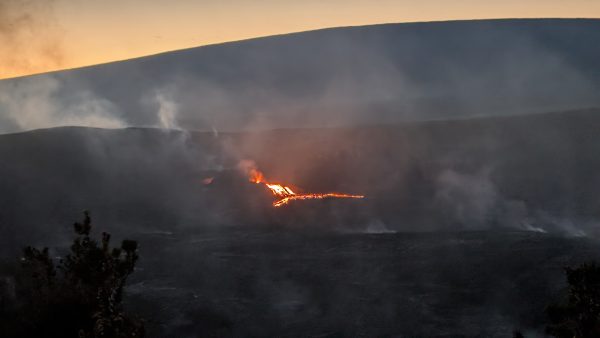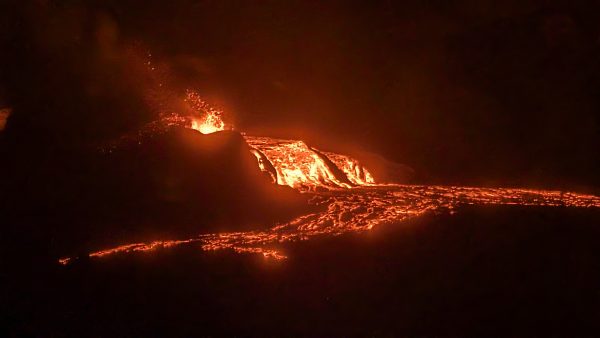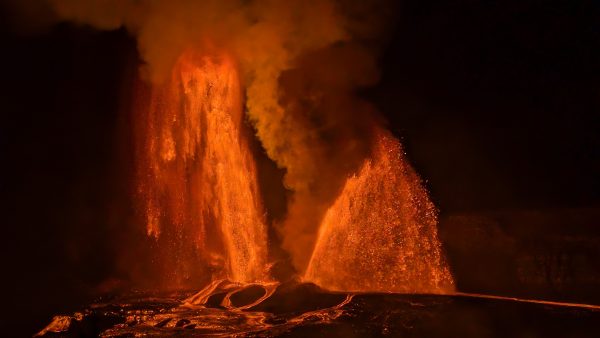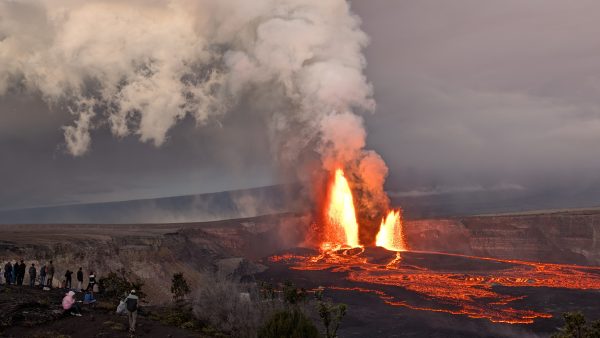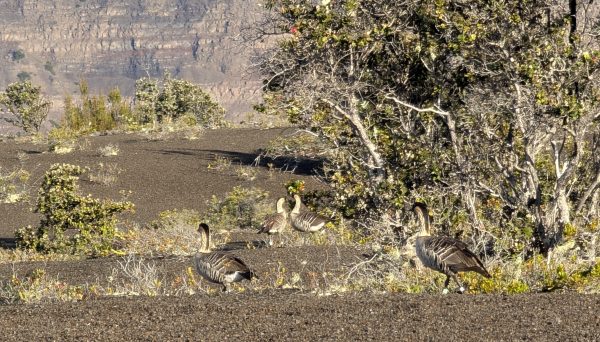The wait, despite the shorter expected interval, was longer this time. It started with the first visible pooling of the lava on the webcam at 2000. We continued to watch until we saw overflow at around 2145. Decided it was time to head over and start observing in person.
Arrived shortly before 2300, and did not witness another overflow until 0215. There was another almost two hours later. it was fairly strong, and lasted around 11 minutes.
The intervals were about one hour apart until 0700, with longer durations, when they started to decrease. By 1530, they had dropped into the 6 to 8 minutes range. This was starting to look the preliminary activity before the previous eruption.
All of these overflows seemed to have the effect of slowing raising the lip and bottom of the lava waterfall, with the bottom rising faster. There seemed to be less distance between the two by the time of the eruption start.
This state of affairs continued until 2100, when I decided to head back to the parking area and do some watching via webcam, which actually had a better view of the vent when it came to details.
The lot was full, but there was some turnover. A lot of the vehicles were running their engines, i guess because it was humid and foggy, and if you didn't open the windows, it fogged up inside.
The overflows stopped by the time I got to the car, and after several hours of absolutely nothing happening, Suzanne also returned and we went back to our accommodations to eat, recharge dead batteries and get a little sleep.
it was now well into 30 September, which was supposed to be our last full day of the trip. We had the webcam on the wall screen the whole time, and nothing continued to happen until noon approached. By then we decided to return to the parking lot to secure a space, if any were available.
We wasted some time since the overflows were still intermittent. The parking lot had a number of empty spaces when we arrived, but these were slowly filling up. The people started using the parallel spaces, and we decided it was time to return to the overlook.
We managed to replace our previous view spot, as there weren't many there. I didn't notice anyone who looked like they were waiting like we were, as we had the only chairs out there.
The second round of overflow ended around 1900. A couple of hours later I did as the night before, headed back to the car to reconfigure. Dozed off and just before midnight decided to check the camera again. There was heavy overflow from the vent, so called Suzanne to find out when it started. She said she was about to call me. I quickly got myself together, and a half hour later was back out. The sky was glowing red for the last half of the mile walk.
For the next half hour the flow did not let up, and then it seemed like the doming over the vent was turning to jetting. The USGS start of the eruption was put at 0053. For the next hour the height of the jetting got taller, surpassing the height we had seen in the previous eruption. Then at just before 0145, the glow in the South vent began to get brighter. First lava poured out, then it too began jetting. Within a couple of minutes its height was greater than that of the North Vent. And it continued to get higher.
At their best, I was estimating 240 to 300 m/800 to 1000 ft for the North Vent, and 350 to 450m/1200 to 1500 ft for the South. I've not seen a report for the North, but the USGS put the south at 1300ft, so my estimates were in range.
With the eruptions so tall, there was little liquid lava running down the slopes. Instead there was a stead rain of solidified lava. At times the jets were obscured by a curtain of this material. We could also see it being swept upwards by the convection current, which made height estimation a bit difficult.
With two lava columns, we could feel a bit of warmth coming from that direction, surprising considering the distance.
It wasn't until about 0400 that it started to look like the height was decreasing. Around 0530 I thought that the power of the columns was decreasing, but they kept coming back.
By then it was getting light. The night started out clear, but as it got lighter, the clouds turned to mist. It never turned into rain, but the area got wet.
Finally, around 0650 it be came obvious that the end was near. The South vent height dropped rapidly, ending at 0700. The North Vent continued for another three minutes before it also quit.
For the first few hours the crowd was well behaved. Around 0300 the Asian selfie mobs started to appear. At one point the took over a huge area beyond the rope boundary to the left of us, and proceeded for the next hour to prance around making idiotic poses and gang gestures. It got kind of tiring to see these same gestures over and over by people who seemed to be under the impression they were being witty and original. At a couple of points we had to yell at some of the selfie gaijin, as they were stop waving their overly bright lights in our direction, or getting too close to the cliff edge slope. I came to the conclusion that the best way to describe these people is that "they were not here to see the volcano erupt, but to be seen at the volcano eruption". It would have been easier and cheaper, in both time and money, so do their antics in front of a large screen projector. (I hope and expect to see so-called AI created selfies in the near future. Then maybe the selfie plague will end when no one will believe you were there.)
Just before the eruption ended, at dawn, a flock of nene (Hawaiian geese) flew behind us. As in Yellowstone, it appears they commute into an area in the morning, hang around for the day, then disappear at sunset. We saw them (with multiple tourists getting too close) on our way back to the parking lot.
The order of events we saw were quite similar in both eruptions we saw, but more drawn out this time, despite the shorter interval. At times it seemed the volcano was deliberately going slow to make sure we could not make our original travel plans for home. As it was, the eruption started after our deadline for leaving. Fortunately, we had alternate flights booked, and were easily able to extend the car rental. It was midday after the eruption ended when we were able to find a place to stay.
On the evening of 02 October, I felt the 3.7 earthquake at 2029 located just south of Pahala. It was like the rumbling for a second of a piece of heavy equipment (electric generator, for example) starting up. Outside, the frog noises, which are loud and constant much of the night, decreased for a moment or two. Suzanne didn't feel a thing.

